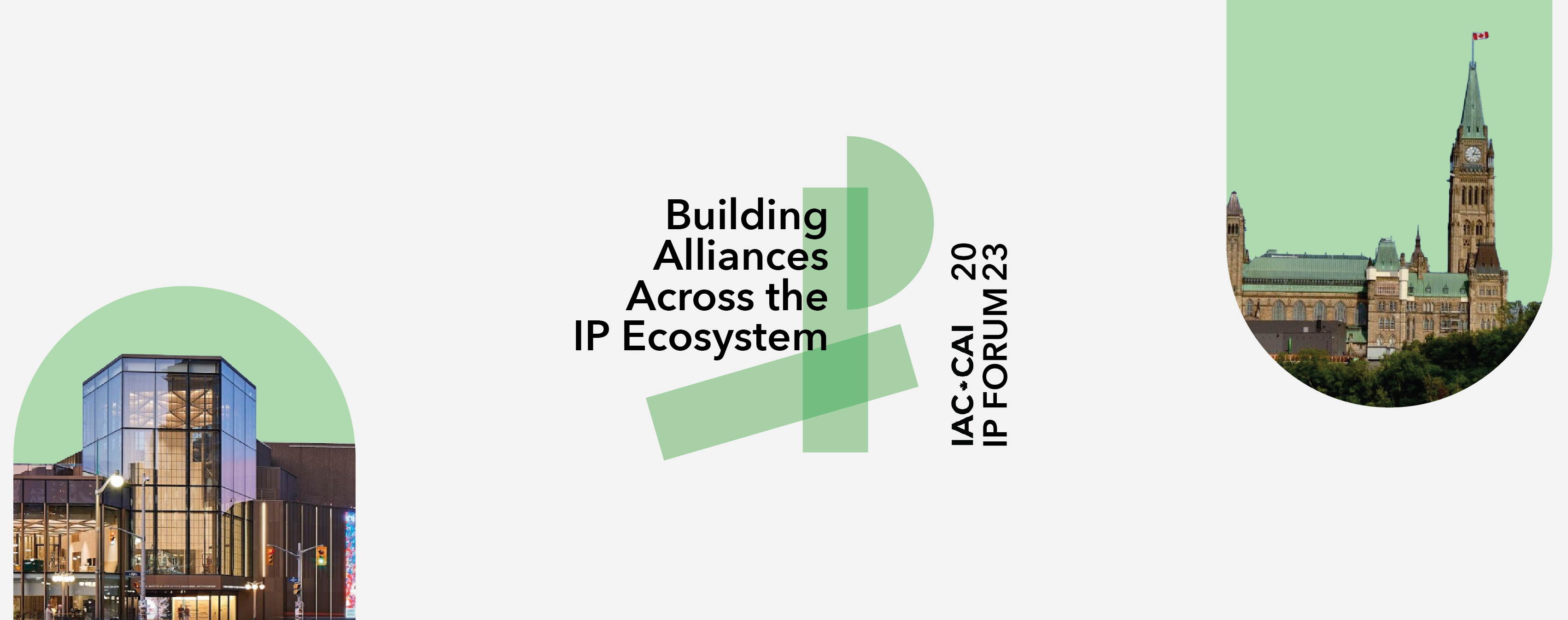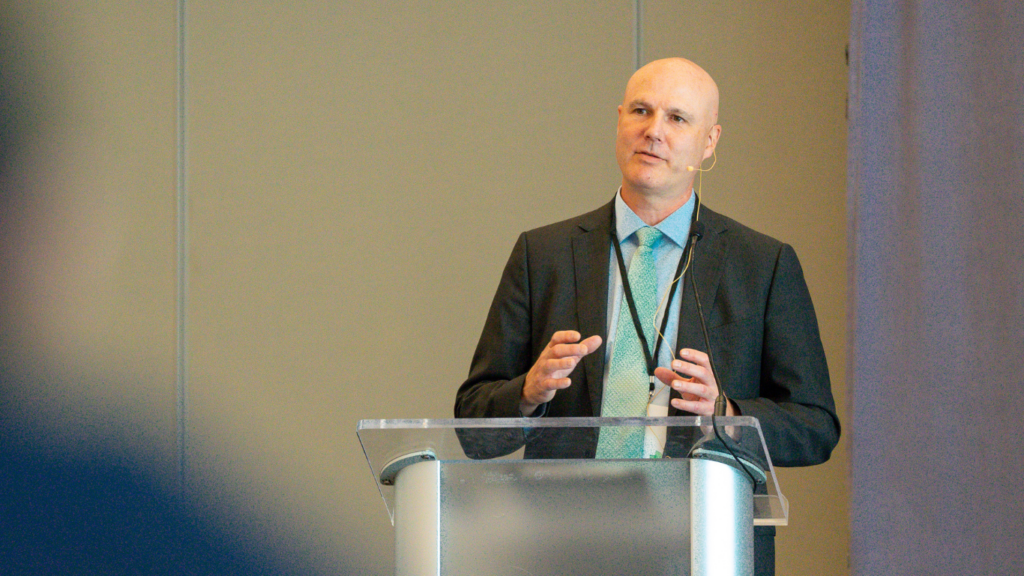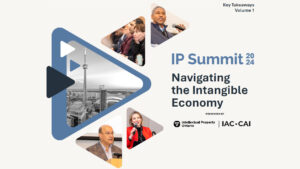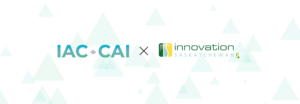It’s time to scale Canada’s national IP strategy
Published
July 21, 2023
Views
1318
Topics

On May 10, 2023, IAC’s IP Forum convened a group of business leaders, policymakers, and IP experts to discuss Canada’s IP ecosystem – how to strengthen it and increase collaboration and coordination. This article outlines some high-level takeaways as well as proposed next steps in building national and regional collaborations to protect Canadian innovation.

“We all know Canada faces an ongoing IP challenge. As most sectors of the global economy have become increasingly dominated by technological advances, the generally poor IP position of Canadian innovators is creating a landscape where foreign operators are thriving at Canada’s expense.
IAC is in a unique position to help shape the future of Canada’s innovation economy through our ability to bring the right people into the room to create a culture shift.
Our inaugural IP Forum did just that.
I am proud we were able to convene business leaders, policymakers, and IP experts to create tangible solutions through collaboration and collective action.”
Mike McLean, CEO, Innovation Asset Collective

It’s time to scale Canada’s national IP strategy.
Canada is a world-leader in ground-breaking innovation in AI, quantum technologies, advanced materials, cleantech and precision medicine, to name but a few sectors. Yet Canada’s famous innovation paradox is that while Canadian academic research is well-regarded internationally, Canadian business innovation, by contrast, is weak by international standards. This is viewed as the primary cause of Canada’s poor productivity growth*. More competitive countries have a national plan to secure ownership of their ideas, and without such a strategy in Canada, there is no clear path to commercialization for Canada’s emerging technologies, increase Canada’s share of global trade and become global technology leaders. Co-keynote speaker, Fellow in Residence with the C.D. Howe Institute and Senior Fellow with the Centre for International Governance Innovation, Dan Ciuriak, summarized this perfectly, “A plan is better than no plan. If we don’t have a strategic plan in place, we are living on hope.”
Co-keynote speaker and Managing Director of Digital Economy at the Centre for International Governance Innovation (CIGI), Bob Fay, noted that globally “we are amid a shift in markets, technology, and competition. We are now seeing gross economies of scale, driven by reliance on data and the ability to derive insights within. But Canada does not have a framework in place to capture these insights, prioritize IP ownership, or lead in any area of the data value-chain for companies to build market capital and scale”.

Why IAC and its IP Forum?
IAC is a key pillar of Canada’s national IP strategy and the first program that considers the broader relevant IP needs of companies using a patent collective approach. IAC’s visionis to revolutionize the IP ecosystem and how Canadian SMEs leverage IP strategy to compete and scale. IAC’s missionis to empower the sustained success of Canadian SMEs through leadership in IP strategy and its use to create global business advantages.
The IAC IP Forum is an extension of IAC’s vision and mission. This year’s theme, Building Alliances Across the IP Ecosystem, explored ways to work across jurisdictions to pool impact, and establish unified goals for a national IP transformation with an eye to the future, allowing Canadian companies to grow, scale, and build a prosperous, sustainable economy.

Canada Needs Flexible Frameworks that Enable Action
Forum attendees agreed these kinds of gatherings are crucial to ensure that we are designing coordinated efforts and using appropriate KPIs to track our impact on driving innovation and increasing productivity in Canada. “Policy coordination is essential… There are many efforts, but they are individual, and not knit together with a common framework.” – Bob Fay
“There are only a certain number of IP experts to draw on across Canada, so how do we pool our expertise and resources and ensure we are sharing best practices and creating interoperability, to the extent it’s possible? Everyone here has a certain role, but we need to get on the same page with who provides what, to ensure companies get the best deal” – Jesse Vincent-Herscovici, CEO, Axelys
A successful framework needs to be adaptable to different industries and regions. “[A solution] is not monolithic, or one size fits all,” noted Mark Schaan, Senior Assistant Deputy Minister, ISED, “There’s continued experimentation required to see what needs to happen going forward. Education, awareness, and understanding all remain a significant challenge [when it comes to viewing intangible assets as business tools]. A framework that allows flexibility is key. The diversity of what we’re optimizing for makes this challenging. You enter this very differently depending on where you’re coming from. First: where IS there a common cause? Where can we make meaningful connections? We’re going to need to customize. A key example on capacity is with the Indigenous IP program – born of a series of conversations with indigenous communities who ISED worked with, saying you can’t ask us to participate in this ecosystem until you build capacity for us to engage in the subject matter. First recognize where people are at…we must recognize and think through the diversity of where people are coming from.”
Frameworks should also touch on the effects that emerging technologies such as AI has on economics, national security, society, and culture. These technologies currently “affects all of our ecosystem but there are no frameworks or guardrails in place to govern [them],” posits Bob Fay.
Support also is needed for frameworks around developing IP sophistication such as the IAC IP Maturity Framework ™ which requires a deep understanding of business issues and principles of continuing education on top of developing IP knowledge and skills. This series of tools can ideally be used by companies and programs across the ecosystem to diagnose and track a company’s IP maturity level using common metrics and then build bespoke support based on where each company is at and where they need help to grow and scale.
According to Paul Lin, Managing Director of Eagle Forest LLC, “Money is always going to be a constraint for startups. It’s not realistic to apply the same goals…but national roadmaps are key. If you take a short-term view on IP, you will almost always end up a failure…if [Canada doesn’t] have the right strategy from the beginning, you will lose.”

“If the right IP structure is put into place, [we] can track and support that company as they move through the programs. We have an opportunity to be with companies over 5-10 years through multi-stakeholder support structures. We can use our network to get good data through these different interactions up the chain.”
Peter Cowan, CEO, IP Ontario and Board Member, IAC

Drive Value from Innovation
While there may be many funding sources for Canadian SMEs across the public and private sector, few KPIs and incentives are tied to the actual real-world deployment of R&D and invention. To be successful, these models should consider the ownership position created around the invention. This includes what IP and data the funding is generating, and how the innovation can be protected to remain in Canada and drive value for the benefit of all Canadians.
Attendees collectively agreed that immediate action should be taken to ensure that federal and provincial R&D investment programs include guardrails on the IP generated by those investments. This includes adapting evaluation methods and training program officers in understanding the importance of having a robust IP strategy and the risks associated with not having one.
Another method to understand incentives is to look at peer countries for examples on establishing metrics on innovation. China, for example, started their national patenting push 10 years ago with an incentive program to increase patent numbers. As the strategy matured, they shifted the focus to quality rather than just quantity.
Paul Lin noted, “just having incentive programs does not necessarily move the needle. The right incentive programs can drive the right behaviours, certainly – but the wrong incentive programs will drive the wrong behaviours.”
“People in IP intensive industries make more money than in non-IP intensive industries.” commented Suzanne Harrison, founder of Percipience LLP, encouraged creating differentiation in the marketplace. “Denmark used this data to create incentives for companies to focus on IP. All countries are trying to link private and public entities together more seamlessly.”

Connecting IP to the C-Suite to Use IP as a Value Multiplier
“If you build it, they will come” may not be an effective strategy when it comes to training companies on developing an IP strategy. Instead, our ecosystem can consider incentivizing Canadian companies to obtain advanced IP education and develop a common understanding of how to leverage and protect their IP and data as tools to protect and scale their companies.
Concepts surrounding IP can be introduced early in the education cycle to underscore the importance of innovation to human progress, economic development, and climate mitigation. This will flow naturally into the Elevate IP initiatives and other programming.
Training should not end there. Executives need to learn to see IP as a business tool and a value multiplier. Joff Wild stated it simply, “connecting IP to the C-suite is critical to sustainability of the IP function and the company.” Konstantinos Georgaras, President of CIPO, shared that “as part of the national IP strategy work with ISED, we conducted an IP awareness survey of 16,000 companies.
Almost 60% found IP gave them direct benefit to their business; only 4% has an IP strategy in place.” Collectively we have an opportunity to address this.
An appreciation of how closely innovation is tied to economic prosperity and how precarious Canada’s situation would be beneficial for taxpayers. As shown in research published in 2021 by BCBC (Williams, 2021), and in the Globe and Mail (Williams and Finlayson, 2022), the OECD projects that Canada will be the worst performing economy out of 38 advanced countries over the next forty years (2020-2060), achieving the lowest growth in real GDP per capita – the most important measure of overall prosperity. The Canadian public could benefit from a better understanding of the importance of protecting Canadian IP to scale our SMEs and retain more ‘anchor companies’ in Canada, creating jobs and wealth to maintain our high standard of living.
We can also encourage current IP experts to collaborate and actively train the next generation of professionals in Canada. This not only includes lawyers, agents, and strategists, but also developing business-centred IP trainers and in-house experts. Attendees agreed that IP literacy must be a collaborative effort.
As a group, we can action data-sharing and collaboration frameworks with short, medium, and long-term objectives. KPIs can be created across the ecosystem to measure and track progress. To ensure outcomes serve all Canadians including underrepresented and equity-deserving groups, EDI frameworks need to be incorporated. “When you look at inventors listed on patents, only 14% are represented by women. So that’s a gap. It is not unique to Canada, and in fact, very similar in most developed countries…Is there a barrier that we need to understand?” – Konstantinos Georgaras, President of CIPO
As Karima Bawa, CEO of 3D Bridge Solutions, Chair of IP Ontario and Senior Fellow at CIGI put it, “We need to create a culture shift. We need to work together; we can’t do it in a vacuum.”

Where Do We Go from Here?
The results from this year’s IP Forum demonstrate the value of convening key stakeholders and building alliances to solve key issues facing Canada’s innovation economy. It is clear this group understands the long-term issues Canada will face if we do not have an adaptable and inclusive innovation framework based on collaboration.
Attendees agreed that now it is time to act and ensure others help create a national culture shift to keep the ownership of Canadian ideas in Canada. We can do that by investing to scaling and sustaining programs launched to address freedom to operate and IP capacity building. These efforts are long-term, and outcomes require support beyond pilot projects. Existing incentive programs should be evaluated to understand what they specialize in and how they fit into a national strategy.
The IAC IP Forum brought forward a myriad of thought leadership. To maintain this momentum, we should consider convening a broader set of perspectives at future events of this nature. This includes more government departments, economists, ESG experts, higher education experts, data experts and more companies and industry associations.
IAC looks forward to engaging with attendees individually and collectively to continue these discussions and support the building of these frameworks to address these critical issues. We thank you for your participation and engagement in driving this culture shift we are collectively working to create across the country.









